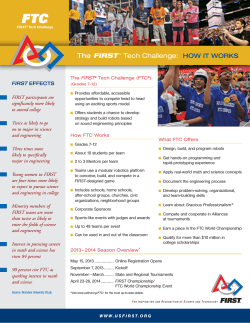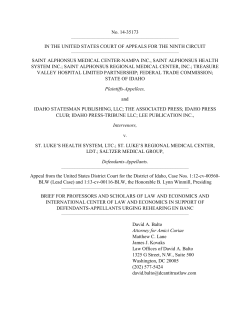
“Examining Health Care Competition” Workshop
Health Care Antitrust Alert Health Care Competition Follow-up Exam: Highlights from the Second FTC/DOJ “Examining Health Care Competition” Workshop 03.02.2015 BY FARRAH SHORT Last week, the Federal Trade Commission (FTC) and the Department of Justice (DOJ) co-hosted the second Farrah Short, Associate installment of their public workshop series, “Examining Health Care Competition.” Complementing last year’s focus on trends and innovation in the health care industry, this year’s two-day workshop explored recent developments related to health care provider organization and payment models. The agencies’ goal for the workshop was to identify and examine the potential competitive implications of strategies currently used by providers and payors seeking to reduce costs and improve quality. The discussions were informed by RELATED PRACTICES Antritrust Health Care Antitrust distinguished panelists from academia, government, and the private sector, including Dionne Lomax from Mintz Levin’s antitrust practice. FTC Chairwoman Edith Ramirez opened the workshop with remarks reiterating the FTC’s position that the goals of health care reform are consistent with — and do not supplant — competition policy. She lauded the FTC’s recent success in the Ninth Circuit St. Luke’s decision as affirming that position. Acknowledging the complexity of the evolving health care industry, she said the antitrust agencies grapple with assessing the promise of new provider structures and payment models against their potential impact on competition. In considering trends in health care competition, she also expressed a developing interest in cross-market mergers. The second day of the workshop was opened with remarks by DOJ Assistant Attorney General for the Antitrust Division William Baer, who likewise highlighted the importance of developing the agencies’ understanding of the changes and challenges facing the health care industry. He also affirmed that the DOJ will continue to challenge conduct that enhances market power, stifles pro-consumer innovations, and increases the risk of higher cost and lower quality health care. He further expressed the DOJ’s “strong preference” for structural remedies, rather than conduct remedies, when challenging horizontal mergers. The importance of the discussions was framed with an overview of some key attributes of the health care system, the single largest industry in the United States with more than 80% of the costs attributed to chronic illness, and over half of the spend going to hospitals and physicians. A key theme throughout the two-day workshop was whether there is a true tension between the goals and requirements of the Patient Protection and Affordable Care Act (ACA) and antitrust laws. The antitrust agencies clearly believe there is no conflict. The enormous challenge of controlling health care costs while improving quality — goals of the ACA — is largely being addressed by payors and providers through innovations in payment models and provider structure. The workshop included panels on (1) provider network design, contracting practices, and regulatory activity; (2) early observations regarding health insurance exchanges; (3) early observations regarding accountable care organizations (ACOs); (4) alternatives to traditional fee-for-service payment models; and (5) trends in provider consolidation. The panels were kicked off with a prediction of certain inevitable trends in health care, including a shift in payments to focus on value and risks, the digitization of health care, and an increase in the number and types of providers. Provider Consolidation A long-standing hot topic in health care antitrust enforcement is provider consolidation. While opinions were mixed, the panelists largely were skeptical about the benefits of consolidation, with many speakers pointing to RELATED INDUSTRIES Health Care the recent Ninth Circuit St. Luke’s decision. However, at least one panelist suggested that while continued consolidation is worrisome under a fee-for-service model, it is less of a concern under risk-based payment models because incentives to keep costs down and improve quality will exist in the new payment structure even if they are lost in the form of competition. The most provocative discussion related to cross-market consolidation and the possible competitive theories of harm. Traditionally, most hospital-hospital and hospital-physician merger cases have turned on the relevant geographic market definition. Cross-market consolidation between providers in different geographic markets could be difficult to challenge because of the need to define a relevant geographic market. Nonetheless, a few panelists suggested possible harm could be tied to common customer or common insurer effects, where a payor needs to sell to customers in different geographic areas. Cross-market consolidation between providers with different products or services likewise might be difficult to challenge because of the need to also define a relevant product market. One theory submitted for this type of challenge relates to the bundling of services, where a payor cannot compete without both types of products. The workshop also addressed whether efficiency arguments still have a place in defense of provider consolidations, again in light of the recent Ninth Circuit St. Luke’s decision. One panelist suggested that perhaps quality improvements are more appropriately considered under competitive effects rather than efficiencies. Network Design One method being developed by payors to address rising costs is the creation of new forms of provider networks, including narrow networks and tiered networks. One panelist observed that while narrow networks are likely a powerful tool to control costs because steering incentives are stronger, tiered networks have potential for broader consumer interests because they provide more choice. Nonetheless, some panelists argued that tiered networks have been slow to develop (with certain exceptions, such as Massachusetts) because provider contracting demands have impeded payor efforts. It was also noted that the ACA health insurance exchanges are the ideal market for narrow networks because individuals directly purchase coverage. In contrast, tiered networks were viewed as more compatible with ACOs. Health Insurance Exchanges Health insurance exchanges are another innovation designed to expand access to and promote competition between payors. There is significant variation in how states have designed and implemented the exchanges, ranging from state-based governance to the default federally facilitated exchanges. To date, the data is mixed regarding the degree to which the exchanges have increased payor participation and competition. Some panelists suggested that a key challenge facing new payor entrants is the need to balance offering a low-cost plan while still pricing at a level that is sustainable. Alternative Payment Models The development of alternatives to the traditional fee-for-service payment model is a further attempt to control cost and improve quality. There are three main categories of payment reform models: upside models (e.g., shared savings, pay-for-performance, gainsharing); downside models (e.g., readmissions and length of stay policies); and two-sided risks (e.g., bundled payments and global payments). Thus far, the upside models are the most common, but the result of all of them to date appears to be a shift of spending away from specialty care to primary care, which is in line with the evolution of the patient-centered medical home concept. Accountable Care Organizations These new payment models and shifts toward a focus on primary care can also be seen in ACOs which aim to promote seamless coordinated care for a defined population where the provider bears risk for the quality and cost of that care. The success of ACOs thus far has been tied to strong clinical leadership, transparency and communication, innovative methods of care coordination, a commitment to practice redesign, and good quality metrics. ACOs combine efforts to transform the delivery of medicine with changes in how providers are paid. One panelist noted that the challenge going forward for ACOs and new payment models is to create a structure where providers can compete for new patients on quality and costs, rather than just rewarding them for achievements with their current population. Conclusion As expected, industry stakeholders utilized the workshop to advocate for a range of conflicting policy positions, relying on varying amounts of empirical support. One interpretation of the overall trends discussed at the workshop is that there are two competing visions for a reformed health care system: One view is that the system should be built on many competing health insurance plans, such as those in the exchanges, which is the ideal type of market for narrow networks which rely on many small physician practices. Alternatively, another vision is a system designed around fully integrated care which relies on larger health systems. The question is whether these positions can be reconciled. Additionally, echoing last year’s workshop, it was generally agreed that the full potential of any of the innovations can only be achieved with better transparency for consumers in terms of price and quality metrics. The FTC and DOJ will clearly continue to have an active interest in and focus on competition issues in the evolving health care industry. The workshop may result in further study, reports, or guidelines on antitrust considerations in the health care industry. The agencies are accepting public comments in response to the workshop until April 30, 2015. Speaker presentations and panel recordings from the workshop will be made available here: http://www.ftc.gov/newsevents/events-calendar/2015/02/examining-health-care-competition. If you have any questions about this topic, please contact the author(s) or your principal Mintz Levin attorney. Copyright © 2015 Mintz, Levin, Cohn, Ferris, Glovsky and Popeo, P.C. 4707-0215-NAT-AFR-HC
© Copyright 2025


















